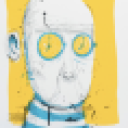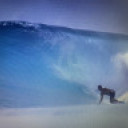SupaWallace escapades


What a fun guy you are!
Edit: loses something being on a new page….



Quite enjoying the thread. Educational and interesting.


blackers wrote:What a fun guy you are!
Edit: loses something being on a new page….
Blackers. You’re the best, I’ve always got mush room for your great comments. AW
One of my favourite moments, accidentally coming across Eucalyptus deglupta Rainbow Gum on Sulawesi in the Lore Lindu National Park at 1700mm.
This is the northern most species of Eucalyptus extending right up into southern Phillipines as well as Sulawesi.
It highlights the once tropical rainforest origin of Eucalyptus radiation.
The progenitor of all Eucalyptus species is the native plant on New Caledonia, Arillastrum gummiferum a totally original rainforest plant.
Coupled with Allosyncarpia ternata in Northern Territory and Stockwellia quadrifida in the Atherton Tablelands and Eucalyptopsis found in New Guinea and the Moluccas.
These four plants are the ancestors of known Eucalyptus sp.


Roadkill wrote:Quite enjoying the thread. Educational and interesting.
Roadkill. Hi mate. Hope you’re well.
I’ve got loads more to post between surfing, let alone all the 246 species of endemic birds we saw, my colleague is handling that end. I’ll upload bird stuff when I get it. All the best. AW


Out of interest, how big are the flowers of the Nepenthes (eg the black lipped one) in your photos AW?


Hey AW / Super and all really enjoying this thread your trip AW is amazing thanks for sharing plus the education as well cheers.


Yes, incredible thread.


blackers wrote:Out of interest, how big are the flowers of the Nepenthes (eg the black lipped one) in your photos AW?
Blackers. Hi mate.
The Nepenthes sp. Pitcher Plant with the dark chocolate lip are approximately 250mm in height with a 50-75mm diameter aperture. They were the largest.
There physiological characteristics are such that they are one continuous plant either trailing and rooted to the ground or just trailing and climbing up to great heights.
I love all the prickly hairs on the front of them to deter mammals from attempting to stick their heads in and drink. There are downwardly pointing hairs on the internal walls of the pitcher, they detect vibrational movement and force prey to slide down into the acid liquid of ‘death’.AW


I focus wrote:Hey AW / Super and all really enjoying this thread your trip AW is amazing thanks for sharing plus the education as well cheers.
I focus. Hi mate. Kind words appreciated.
We all like learning, we are learners, including myself. AW



Regular daily scenes, very early starts, very late finishes. It was totally epic.



AlfredWallace wrote:blackers wrote:Out of interest, how big are the flowers of the Nepenthes (eg the black lipped one) in your photos AW?
Blackers. Hi mate.
The Nepenthes sp. Pitcher Plant with the dark chocolate lip are approximately 250mm in height with a 50-75mm diameter aperture. They were the largest.There physiological characteristics are such that they are one continuous plant either trailing and rooted to the ground or just trailing and climbing up to great heights.
I love all the prickly hairs on the front of them to deter mammals from attempting to stick their heads in and drink. There are downwardly pointing hairs on the internal walls of the pitcher, they detect vibrational movement and force prey to slide down into the acid liquid of ‘death’.AW
Cheers, so quite a significant flower. I have often found the carnivorous plants I have found here disappointingly small, eg sun dews and the like.. Glad to see some monsters exist.


blackers wrote:AlfredWallace wrote:blackers wrote:Out of interest, how big are the flowers of the Nepenthes (eg the black lipped one) in your photos AW?
Blackers. Hi mate.
The Nepenthes sp. Pitcher Plant with the dark chocolate lip are approximately 250mm in height with a 50-75mm diameter aperture. They were the largest.There physiological characteristics are such that they are one continuous plant either trailing and rooted to the ground or just trailing and climbing up to great heights.
I love all the prickly hairs on the front of them to deter mammals from attempting to stick their heads in and drink. There are downwardly pointing hairs on the internal walls of the pitcher, they detect vibrational movement and force prey to slide down into the acid liquid of ‘death’.AWCheers, so quite a significant flower. I have often found the carnivorous plants I have found here disappointingly small, eg sun dews and the like.. Glad to see some monsters exist.
Blackers. Hi fella.
Our sun dews / honey dews (Drosera sp.) are probably that very small size due to the prey they often snare, that being ants. AW


Which begs the question, what do these big feckers catch? I am guessing that the large size is also due to the fact there are fewer environmental stressors applied to organisms growing in tropical rainforests compared to say the highland/alpine moors or costal plains of southern Aus.


Sulawesi views.
Bitung.
Bogani Nani Wartabone National Park
Beautiful endemic birds bird from Halmahera in the Nth. Maluku Islands (Mollucans)
Azure DollarBirds and Spectacled Imperial Pigeons.


That Bitung shot is very good.


Those last two birds look like they had some good disco biscuits at the rave last night.


blackers wrote:That Bitung shot is very good.
Isnt it, lots going on, great frame.


blackers wrote:That Bitung shot is very good.
Blackers. I’ve looked at that photo a lot, it is as you say , very good. Typical view in the mornings in these forests, the sounds of birds animals and insects, already up and up about. AW


seeds wrote:Those last two birds look like they had some good disco biscuits at the rave last night.
Seeds. Hi mate. Hope ya well.
Ah, you are right on the money of the DollarBirds ,but you have described the Spectacled Imperial Pigeon eyes to a tee. A white ring around the eyeballs from being on the Bill Lawry pigeon fanciers disco grain.
These birds white spectacles came about through isolation and speciated on Halmahera and other nearby islands a (Wallacean endemic)
West and south of there they lack those rings and are just Imperial Pigeons with Seram Imperial Pigeons found on the island of Seram, so, your suspect behaviour is well, suspect. AW


Hmm, suss cunts, or am I a suss cunt?
Sounds Shakespearean. Haha
Wish I was there old mate!


blackers wrote:Which begs the question, what do these big feckers catch? I am guessing that the large size is also due to the fact there are fewer environmental stressors applied to organisms growing in tropical rainforests compared to say the highland/alpine moors or costal plains of southern Aus.
Blackers. They eat rodents , small birds, frogs, large insects and reptiles. AW


seeds wrote:Hmm, suss cunts, or am I a suss cunt?
Sounds Shakespearean. HahaWish I was there old mate!
Seeds. Yeah, it would’ve been great if you had been part of our company, I’d imagine you’d love every bit of it. Some other day maybe. Supa and I are in a hotel room close to the airport, we fly to Sumatra late morning, Bali traffic is hell so best to be close by. Catcha, tired. AW


Sleep well. I hope the air con is working.


AW farts in his sleep .


Hope the air con was switched off











































cos, y'know.. we're curious.
PB & J, or 'the original odd couple'.
either way, stay social boys.